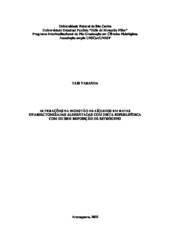Alterações na ingestão de líquidos em ratas ovariectomizadas alimentadas com dieta hiperlipídica com ou sem reposição de estrógeno
Abstract
In recent decades, obesity, a non-communicable disease, has become a worldwide epidemic. During obesity, reductions in water intake have been described in humans and animals. In addition to obesity, dehydration affects a portion of the Brazilian population, especially in times of warmer weather. Experimentally, dehydration can be induced by water deprivation (WD), which induces thirst, due to the activation of osmoreceptors and the action of ANG II on angiotensin II receptors type 1 (AT1) receptors in the central nervous system (CNS), and ingestion of hypertonic sodium solution, by the action of ANG II on AT1 receptors in the CNS. During menopause, disorders in the water and sodium intake are commonly observed, due to the absence of the hormone estrogen. Experimentally, estrogen treatment in ovariectomized (OVX) rats has been shown to be effective in reducing these changes. Thus, we were aimed to study the daily water and sodium intake in intact females, and in OVX rats lacking 17-β-estradiol (E2) or E2 replacement that were fed a high-fat diet. Possible changes in water and sodium intake induced by 24-hour PH were also studied. In order to study that, Holtzman females (260-300 g) were placed in individual cages, with free access to food, water, and 0.3 M NaCl solution. During one week daily water and sodium intake was registered, while all rats were kept intact and fed with SD, allowing the verification of basal intake values in these animals (baseline week). Last week, the rats underwent OVX or sham surgery (SHAM) and were fed either SD (11% calories from fat) or HFD (46% calories from fat) for 6 weeks. After 3 weeks of diet, part of the OVX rats received treatment with E2 (10μg/day/rat) for the next 4 weeks. Spontaneous ingestion of water and 0.3 M NaCl was recorded daily for 6 weeks, and body weight was assessed weekly. At the end of 6 weeks, for induction of thirst and sodium appetite, the WD-Partial Rehydration (PR) protocol was used. Briefly: the rats were maintained with only chow for 24 h and then, a water burette was offered for 2 h (PR – thirst test), and then an additional burette containing 0.3 M NaCl was offered for another 2 h (sodium appetite test). At the end of the experiments, the analysis of plasma values of insulin, leptin and E2 were performed, and visceral adipose tissue and uterus were collected and weighted. The main findings were: 1) HFD rats, compared to SD rats, had increased body weight gain, visceral adipose tissue and plasma leptin, and all these parameters were potentiated in HFD/OVX rats and reversed by E2 replacement (HFD/ OVX+E2); 2) A reduction in daily water intake was observed in HFD/SHAM or HFD/OVX rats, compared to SD rats with the same treatment, in HFD/OVX+E2 rats the values of spontaneous water intake returned to values similar to those observed at baseline; 3) spontaneous sodium intake was increased in HFD/SHAM rats when compared to SD/SHAM rats; 4) in HFD/OVX rats, E2 treatment (HFD/OVX+E2) restored the increased sodium intake; 5) Compared with SD/SHAM rats, HFD/SHAM rats ingested less water and more sodium when submitted to 24 h of WD; 6) In SD/OVX rats, there was a lower water intake induced by WD, which was not reversed by the E2 treatment; 7) OVX did not change the sodium intake induced by WD in SD rats, but with E2 treatment there was a reduction in sodium intake induced by WD, 8) On the other hand, water intake after WD in HFD/OVX rats was lower than in HFD/SHAM rats, as well as the sodium intake; 9) In HFD rats, E2 treatment restored both
water and sodium intake. Therefore, while in SD rats E2 appears to have an inhibitory effect on sodium intake only during WD, in HFD rats the effect appears to be excitatory for both water and sodium intake in spontaneous or WD-induced ingestion.
Collections
The following license files are associated with this item:

